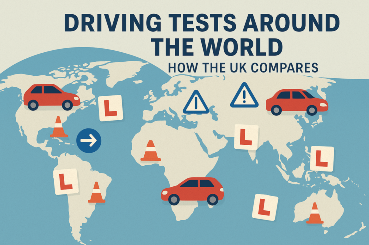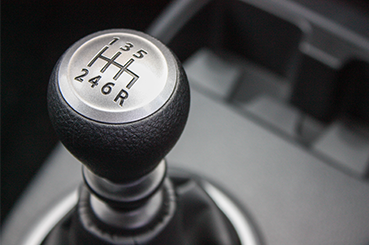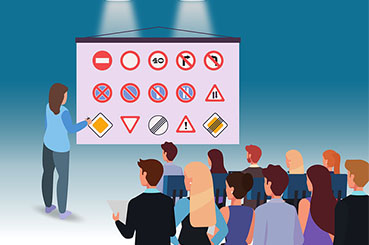Ever feel like the driving test throws curveballs your way? Well, those unexpected questions at the start might not be so random after all. They’re the famous “show me, tell me” questions, and mastering them can put you at ease on your big day.

What are ‘show me, tell me’ questions?
The Driver and Vehicle Standards Agency (DVSA) uses these questions to assess your knowledge of car safety checks and how you perform them in more than just theory.
You’ll get one “tell me” question before you even start driving, designed to gauge your understanding of preventative maintenance and routine checks. This is your chance to showcase your knowledge and proactive approach to car safety.
Then, you’ll get a “show me” question while you’re on the road. This practical demonstration allows the examiner to see if you can perform the check smoothly and safely, without compromising your focus on driving.
Getting them right shows the examiner you’re a safe and prepared driver who understands the importance of both theoretical knowledge and practical application.
Why practice these questions?
Simple – they can make or break your test! Answering incorrectly can lead to a “driving fault,” which can add up and impact your overall score.
Messing up the “show me” question while driving can even result in a test fail, because it demonstrates a potential safety hazard. But don’t worry, we’ve got you covered.
By familiarising yourself with these questions and practising your responses, you’ll be building the confidence and knowledge to handle them calmly and effectively on test day.
Tell me questions explained:
These questions ask how you’d perform a specific car safety check, giving you a chance to explain your thought process and the steps involved. Here are some examples (remember, these are not the official answers!):
Brakes:
Q: Tell me how you’d check that the brakes are working before starting a journey.
A: I’d firmly press the brake pedal with the engine off. It should feel firm, not spongy. I’d also check for signs the car pulls to one side when braking.
Tyres:
Q: Tell me where you’d find the recommended tyre pressures for this car and how you’d check them.
A: The recommended pressures are usually in the car handbook or on a sticker inside the driver’s door. I’d use a reliable pressure gauge to check each tyre when they’re cold and inflate them to the correct level. I wouldn’t forget to check the spare tyre and refit the valve caps.
Q: Tell me how you’d check the tyres to ensure they have sufficient tread depth and that their general condition is safe to use on the road.
A: I’d look for any cuts or bulges on the tyres. The legal minimum tread depth is 1.6mm across the central three-quarters of the tyre.
Lights:
Q: Tell me how you’d check that the headlights and tail lights are working. (Remember, you don’t need to physically check during a “tell me” question)
A: I’d turn on the lights switch (and the ignition if necessary). Then, I’d walk around the vehicle to visually confirm all lights are functioning properly.
Q: Tell me how you’d check the brake lights are working on this car. (You can’t physically check during a “tell me” question)
A: I’d press the brake pedal and look for the brake lights to illuminate. Alternatively, I could use reflections in windows or ask someone to help.
Q: Tell me how you’d check the direction indicators are working. (Remember, you don’t need to physically check during a “tell me” question)
A: Similar to the headlights, I’d turn on the indicator switch (and the ignition if necessary) and walk around the car to confirm all indicators are flashing correctly.
Other Important Checks:
Q: Tell me how you make sure your head restraint is correctly adjusted so it provides the best protection in the event of a crash.
A: I’d adjust the head restraint so the top is level with the top of my head or ears, ensuring it’s comfortable.
Fluid Levels: (These questions require opening the bonnet during the test)
Q: Open the bonnet and tell me how you’d check that the engine has sufficient oil.
A: I’d locate the dipstick, remove it, wipe it clean, and re-insert it fully. Then, I’d pull it out again and check the oil level against the minimum and maximum markers. (Similar explanations apply for coolant and brake fluid level checks.)
Lights and Beam Functions: (You don’t need to physically check during a “tell me” question)
Q: Tell me how you’d switch on the rear fog light(s) and explain when you’d use it/them.
A: I’d operate the switch (with headlights and ignition on if necessary) and check the warning light comes on. Rear fog lights are used in foggy conditions to improve visibility.
Q: Tell me how you switch your headlight from dipped to main beam and explain how you’d know the main beam is on.
A: I’d operate the headlight switch and check the main beam warning light on the dashboard.
By understanding these “tell me” questions and practicing your responses, you’ll be well on your way to driving test success! Remember, a confident and prepared driver is a safe driver.
There are many more “tell me” questions the DVSA can ask, so check out the official list and quiz yourself to be super prepared! Find out more here on the Government website.
Top Tip: Practice explaining these checks out loud to a friend or family member, or even record yourself. The more comfortable you are talking about them, the smoother your test will go. Visualising yourself confidently answering these questions can also boost your test-day confidence.
Show me questions in action:
These questions ask you to actually perform a safety check while driving, demonstrating your ability to multitask and prioritise safety. Here’s what they might look like:
During your driving test, the examiner might ask you to demonstrate some car safety checks while you’re on the road. These are called “show me” questions, and they’re your chance to show off your ability to multitask and prioritise safety. Here’s how to tackle some of the most common ones:
Washing the Windscreen (Front & Rear):
Find the washer fluid reservoir: This is usually a translucent bottle under the bonnet (hood).
Locate the washer and wiper controls: These are typically on a stalk behind the steering wheel.
With clear visibility ahead, activate the washers and wipers. Ensure they clean the windscreen effectively.
Using Dipped Headlights:
Identify the headlight controls: These are usually a rotary knob or a stalk on the dashboard.
When safe to do so (dusk, nighttime, or poor visibility), turn on the dipped headlights. Check they illuminate the road ahead without dazzling oncoming traffic.
Operating the Horn:
Locate the horn button: This is usually positioned in the center of the steering wheel.
In a safe and controlled manner (e.g., on a quiet road with no pedestrians nearby), give a short blast of the horn.
Setting the Rear Demister:
Find the rear demister button: This is often a button with a symbol resembling squiggly lines.
Press the button to activate the rear demister.
Demisting the Front Windscreen:
Locate the climate control panel: This might have a dedicated button for demisting or a temperature dial.
Turn on the demister and adjust the fan speed/temperature as needed.
Opening and Closing the Side Window:
Locate the window controls: These are usually buttons on the door armrest.
Press the button to lower or raise the window smoothly, ensuring nobody’s hand is in the way.
Since you can’t really explain much while doing these tasks, here’s a quick list:
- Show me questions involve physically demonstrating a safety check in a smooth and controlled manner.
- Get familiar with the car you’ll be using for the test, so you know where the controls are located and can find them without fumbling or taking your eyes off the road for too long.
Top Tip: Ask your instructor to practise “show me” questions in different cars to be ready for anything on test day! This will help you adapt to the layout of different vehicles and demonstrate your ability to find the controls quickly and confidently.
By understanding “show me, tell me” questions and putting in the effort to practise them, you’ll be one step closer to acing your driving test. Now that you know what to expect, you can approach your test with



















